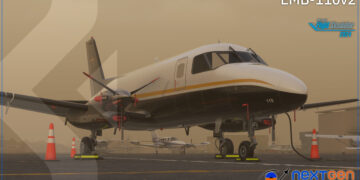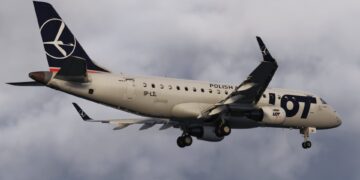Black Square Announced another business turboprop for Microsoft Flight Simulator, and it’s the unique Beechcraft Starship.
Announced in partnership with Just Flight as usual, the aircraft promises to be “technically advanced and unapologetically realistic” and it’ll feature tons of really neat toys that flight simulation aficionados will likely love.
This announcement is also quite exciting due to the reputation built by Black Square, which has released add-ons featuring very high quality so far.
Below you can enjoy a trailer. The store page is also already up, albeit the aircraft has not been released just yet. Pricing info and release date are still pending.
Here’s a list of promised features:
- 185-page manual with your complete guide to flying the Black Square Starship, including systems guide, tutorials, operating limitations, performance tables and electrical schematics.
- Tablet Interface for configuring options, payload settings, failure management and real time visualisers for engines, electrical schematics and environmental systems.
- One-of-a-kind Collins AMS-850 ’14-tube’ (CRT) avionics suite and associated line-replaceable-unit failure logic, quirks, eccentricities and never-seen-again features of the first all-glass panel cockpit and flight management system in a business aircraft.
- Very Low Frequency (VLF) and Omega radio navigation systems from the pre-GPS era. Configure the aircraft to tune stations on the other side of the globe, and manage six DME receivers to maintain accurate position information in a time before GPS.
- Avionics and instrument panel temperature simulation require you to properly manage the equipment cooling systems on the aircraft, or else be faced with electronics and display failures that will necessitate reversionary modes and hardware redundancy.
- 230+ random, scheduled or performance-triggered failures, settable via the tablet interface, including engine damage, compatible with third party UIs and instructor stations.
- Fully simulated environmental control and pressurisation system for heating, air conditioning, ventilation and ram air cooling. Cool things off by opening a door or watch the aircraft heat up in the sun. Monitor via the new tablet interface.
- NEW terrain and weather radar technology creates a functioning terrain radar without the use of WASM modules or external desktop software applications. Aircraft pitch, antenna position, transceiver gain, precipitation rate and altitude all influence the radar depiction.
- Completely simulated electrical system, with 170+ circuit breakers and failures.
- NEW functional windshield wipers clear rain with improved realistic visuals.
- Improved turboprop dynamics, including (ITT, TRQ, Ng, FF, FP), hot starts, residual heat, and exhaust back pressure, P2.5 HP and LP valve simulation and fuel-oil heat exchanger.
- Turbine engine failures, such as compressor stall and surging, fuel control failure, fuel filter clogs, propeller governors and fire suppression systems.
- FOD damage based on surface type. Use the inertial separators to avoid engine damage. Tablet interface displays the type and intensity of FOD.
- NEW physics-driven propeller governor and feathering simulation and beta range from the Black Square Duke
- Floppy disk reader for updating navigation databases and reading other data files.
- Gyroscope physics simulation for electric and pneumatic gyroscopes with precession and partial failures, based on a coupled quadrature oscillator.
- Voltage-based light dimming, an immediately recognisable effect to night-time pilots.
- Strobe light system causes realistic distracting flashes in clouds.
- St. Elmo’s Fire and static discharge on static wicks and windshields in severe weather.
- Mathematically accurate VOR and ADF signal attenuation and noise degradation.
- Physics-based instrument needles bounce and respond to aerodynamic forces.
- Functional exterior elements: chocks, pitot covers, engine covers, gear downlock pins and ground power generator. Pitot cover flags blow in the wind.
- Cathode Ray Tube (CRT) simulation and warm-up based on instrument panel temperature.
- Improper engine management will slowly damage engines to failure.
- Carbon Monoxide leaks are possible and can be detected with the CO detector.
- State saving for fuel, radio selection, radio frequency memory, cabin aesthetics etc.
- Crew/Passenger oxygen depletes according to pressure altitude and passenger occupancy.
- Ultra-custom dynamic registration number system for livery creators.
The sound package is by Boris Audio Works, which is another developer with an excellent reputation.
If you’d like to get into flight simulation but the initial hurdle seems too high, you can read our introductory guide, alongside the second episode focusing on installing add-ons, and another showcasing the basic instruments.
You can also read more flight simulation news in yesterday’s roundup article.












